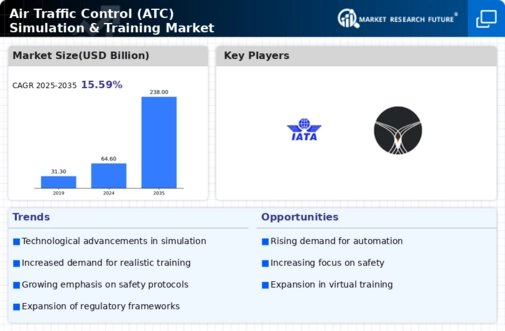Growing Air Traffic Volumes
The increasing volume of air traffic is a primary driver for the Air Traffic Control (ATC) Simulation & Training Market. As more airlines expand their fleets and routes, the demand for efficient air traffic management intensifies. According to recent data, air traffic is projected to grow by approximately 4.5% annually over the next decade. This surge necessitates enhanced training solutions for air traffic controllers to manage complex airspace effectively. Consequently, simulation technologies are being adopted to provide realistic training environments, allowing controllers to practice and refine their skills in handling high-density traffic scenarios. The need for advanced simulation tools is thus amplified, as they play a crucial role in preparing personnel to meet the challenges posed by increasing air traffic volumes.
Integration of Artificial Intelligence
The integration of artificial intelligence (AI) into air traffic management systems is transforming the Air Traffic Control (ATC) Simulation & Training Market. AI technologies are being utilized to enhance decision-making processes, optimize traffic flow, and predict potential conflicts in real-time. This technological evolution necessitates that air traffic controllers are trained to work alongside AI systems effectively. Consequently, simulation training programs are increasingly incorporating AI-driven scenarios to prepare controllers for future operational environments. The market is expected to witness substantial growth as organizations invest in advanced simulation tools that leverage AI capabilities, thereby improving training outcomes and operational efficiency.
Focus on Cost-Effective Training Solutions
The need for cost-effective training solutions is a significant driver in the Air Traffic Control (ATC) Simulation & Training Market. As organizations face budget constraints, there is a growing emphasis on maximizing training efficiency while minimizing costs. Simulation training offers a practical solution, allowing for repeated practice without the associated costs of live training exercises. Furthermore, the ability to simulate various scenarios enables controllers to gain experience in a controlled environment, reducing the risk of costly errors in real operations. This focus on cost-effective training solutions is likely to drive investment in simulation technologies, as organizations seek to enhance their training programs while adhering to financial limitations.
Regulatory Compliance and Safety Standards
Regulatory bodies worldwide are imposing stringent safety standards and compliance requirements, which significantly influence the Air Traffic Control (ATC) Simulation & Training Market. These regulations necessitate that air traffic controllers undergo rigorous training to ensure they are equipped to handle emergencies and maintain safety protocols. For instance, the International Civil Aviation Organization (ICAO) mandates specific training requirements for air traffic personnel. As a result, simulation training has become an essential component in meeting these regulatory demands. The market for ATC simulation solutions is likely to expand as organizations seek to comply with evolving safety standards, thereby enhancing the overall safety and efficiency of air traffic operations.
Emergence of Remote and Virtual Training Solutions
The emergence of remote and virtual training solutions is reshaping the landscape of the Air Traffic Control (ATC) Simulation & Training Market. With advancements in technology, training can now be conducted remotely, allowing for greater flexibility and accessibility. This shift is particularly beneficial for organizations looking to reduce training costs while maintaining high standards of education. Virtual training environments enable air traffic controllers to engage in realistic simulations from various locations, facilitating continuous learning and skill development. As organizations increasingly adopt these innovative training methods, the demand for remote simulation solutions is likely to rise, further propelling the growth of the ATC simulation market.


















Leave a Comment